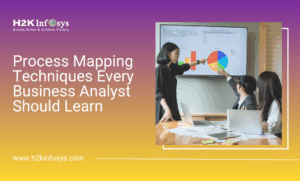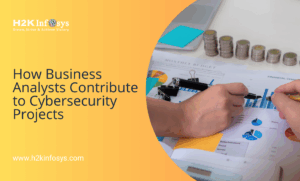The first step in improving company processes is frequent process mapping. It is an essential task that establishes a starting point for measuring changes and is crucial for locating and recognizing improvement opportunities. Mapping Sessions As a result, it’s critical that facilitators gather accurate data to support the proper direction of process improvement projects.
Facilitators must be capable of managing people (resolving conflicts and distractions), leading (guiding the direction of meetings), and convincing participants to open up and share their knowledge for mapping sessions to be successful.
This can be difficult when handling sizable groups and intricate procedures. The following suggestions will help to guarantee that your process mapping session is a success. Check out the business analysis course to learn more.
1.Be Aware Of ‘Scope Creep’
Side chats or off-topic discussions can cause scope creep, which detracts from the meeting’s initial objectives. It may also result in the collection of pointless information. It is simple for a gathering to veer off the subject. There are further obstacles to overcome when doing process mapping workshops.
The purpose of mapping sessions is to record task performance by bringing together SMEs and other groups. But these meetings also frequently function as educational opportunities, providing previously unknown information about a process and its difficulties. This might lead to lengthy debates about difficulties because each member may have a different level of awareness about the process. These talks can lead the meeting off-subject even though they might be instructive and occasionally necessary.
Let’s take an example where Group B is using a tool that Group A could use, and Group A is calculating input for a step using a manual approach. The manual procedure might not be necessary with this gadget. Naturally, this piques group A’s curiosity and turns the conversation away from the meeting’s main goal and toward the tool. When process flaws are exposed, these kinds of tangential or off-topic discussions frequently occur. These conversations need to have a time limit, and the facilitator needs to be able to distinguish between pertinent and irrelevant conversations to protect the goals of the meeting. Recall that the goal of process mapping sessions is to discover and record new problems rather than to solve existing ones.
Another way that mapping sessions might veer off course is when participants feel pressured to record processes as they “should be” rather than as they are right now. After teams have solved challenges, mapping sessions usually end with the design of the “To Be” or “Future State” process. This is done to discover potential for improvement in the “As Is” or “Current State” process. It is encouraging when attendees at meetings identify improved methods of doing things, but it is unhelpful to prematurely document the “Future State” before setting a baseline for the improvement endeavour. The facilitator’s responsibility is to recognize this shift and reorient the group.
2.Capture The Right Amount Of Information
The ability to judge the appropriate amount of material to record is a prerequisite for facilitators. Either extreme can be a waste of time and fail to fulfil the project’s primary goal: gathering too little or too much information.
Most mapping initiatives begin at Level 0, or the steps listed in a SIPOC, according to process mapping guidelines. The roles, inputs, outputs, and high-level steps of a process are identified using SIPOCs (Supplier, Input, Process, Outputs, Customers).
Starting with a high-level map (Level 0) is the best way to determine which topics require further development. In accordance with this, further layers can be mapped (see Figure 1). The following is a description of the different levels:
Level 0: a process’s high-level fundamental steps, described in no more than six steps.
Level 1: delves deeper into the fundamental elements and outlines the subsequent steps in a process.
Level 2 explains a process’s in-depth specifics.
Although you might have to dive deeper to find process bottlenecks and inefficiencies, it’s crucial to consult SMEs regarding the applicability of the data being collected and to routinely assess project objectives in relation to your process mapping activities in order to make sure that you are steering the meetings in the right direction.
3.Make Sure The Right People Are In The Room And/Or Available For Participation
Nothing is more frustrating than having a productive mapping session come to an abrupt halt because nobody in the room is certain of what comes next! You just do not have all the right folks in the room if this happens. Your suppliers, consumers, and other representative organisations that have to be present at the meeting are disclosed by the SIPOC. But occasionally, the proper people aren’t selected to take part. When actual processors should be present or reachable during meetings, supervisors and/or process owners are selected to represent the departments instead. Although sponsors frequently find it difficult to divert important resources from key projects, it is well worth the effort to persuade them to give the right representation so that data may be accurately mapped out during the mapping session.
4.Proactively Address Conflict
Regular meeting attendees, such as business professionals, are well aware of how disruptive attendance can make meetings less effective. Conflict that arises inside departments, organisations, or between people may find its way into your process mapping session and hinder or prohibit you from documenting important aspects of a process.
It’s critical to identify any issues before a mapping session and take proactive measures to address them. How can you get ready before the meeting for these kinds of challenges? Prior to the meeting, undertake a basic or modified risk assessment or change readiness assessment and use tools based on change management concepts. It will be easier for you to plan a response and control behaviour at meetings if you are aware of the difficulties that groups encounter inside their processes and/or between groups.
These are five key points to be aware of before a meeting. Pose the following queries to each process owner and/or sponsor:
- Do you endorse this endeavour?
- What concerns, if any, do you have regarding this endeavour?
- Do your SMEs have the time and resources available to contribute to this project?
- Do SMEs have an incentive to take part in the mapping exercises?
- Are you in a strong position with other organisations, which will help your team collaborate effectively throughout the mapping sessions?
It is best to resolve conflicts in an honest and open manner. Consider the sponsors first. Restate the overarching project goals, be fervently impartial throughout the process, and reiterate the aim. Choosing a side will make the other sides shut down, which will cause you to lose involvement right away and impede accurate data collection. Facilitators will be able to accomplish the objectives of the mapping session by being open and honest about the process and showing courage when facing difficulties.
Conclusion Check out the BA training to learn more about Mapping Sessions.





























